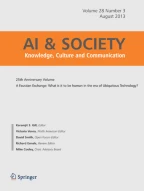Abstract
Marketing communication has recently become increasingly interactive due to the widespread use of social media and requires wider participation by consumers. One method that facilitates this interaction is Shikake, which is defined as a trigger for behavior change. The aim of this paper is to demonstrate the effectiveness of Shikake with respect to enhancing customer engagement behavior, which is defined as customers’ behavioral manifestations that have a brand or firm focus, beyond purchase, resulting from motivational drivers. This paper introduces various approaches that can be used to trigger customer engagement behavior, such as brand relationships, behavioral economics, and human–computer interaction, emphasizes the power of design framing and triggers, and attempts to classify Shikake in the field of marketing according to participants’ motivation and consciousness. Finally, the paper attempts to reveal Shikake’s key success factor in the field of marketing and discusses future research opportunities.
Similar content being viewed by others
Explore related subjects
Discover the latest articles, news and stories from top researchers in related subjects.References
Bargh JA (2002) Losing consciousness: automatic influences on consumer judgment, behavior, and motivation. J Consum Res 29(2):280–285
Bargh J, Chartrand TL (1999) The unbearable automaticity of being. Am Psychol 54(7):462–479
Bettman JR (1979) An information processing theory of consumer choice. Addison-Wesley, Massachusetts
Chartrand TL, Fitzsimons GJ (2011) Nonconscious consumer psychology. J Consum Psychol 21(3):1–3
Deterding S, Sicart M, Nacke L, O’Hara K, Dixon D (2011) Gamification: using game design elements in non-gaming contexts. Proceeding in CHI EA ‘11 CHI ‘11 Extended Abstracts on Human Factors in Computing Systems, pp 2425–2428
Dijksterhuis A, Bargh JA (2001) The perception-behavior expressway: automatic effects of social perception on social behavior. In: Zanna MP (ed) Advances in experimental social psychology. Academic Press, San Diego, pp 1–40
Dijksterhuis A, Smith PK, van Baaren RB, Wigboldus DHJ (2005) The unconscious consumer: effects of environment of consumer choice. J Consum Psychol 15:193–202
Howard JA, Sheth JN (1969) The theory of buyer behavior. Wiley, NY
Kahneman D (2011) Thinking, fast and slow. Farrar, Straus and Giroux, USA
Kraut RE, Resnick P (2012) Building successful online communities: evidence-based social design. MIT Press, Cambridge
MacInnis DJ, Park WC, Priester JR (eds) (2009) Handbook of brand relationships. M.E. Sharpe Inc, New York
MacLeod D (2011). Tontine fresh pillows. http://theinspirationroom.com/daily/2011/tontine-fresh-pillows/. Accessed 10 January 2013
Prahalad CK, Ramaswamy V (2004) Co-creation experiences: the next practice in value creation. J Int Mark 18(3):5–14
Punj GN, Staelin R (1983) A model of consumer information search behavior for new automobiles. J Consum Res 9(4):366–380
Ratchford BT (1982) Cost-benefit models for explaining consumer choice and information seeking behavior. Manage Sci 28(2):197–212
Rossiter JR, Percy L (1997) Advertising communications and promotion management, 2nd edn. McGraw-Hill, New York
Schultz J (2010) Speed camera lottery wins VW fun theory contest.http://wheels.blogs.nytimes.com/2010/11/30/speed-camera-lottery-wins-vw-fun-theory-contest/. Accessed 30 November 2010
Solomon, ME (2006) Consumer behavior: buying, selling, and being, 7th edn. Pearson Education, New Jersey
Takatalo J, Miller D, Hakkinen J (2013) Experience, engagement, and Shikake. AAAI Press Technical Report SS-13-06, pp 95–100
Thaler RH, Sunstein CR (2008) Nudge: improving decisions about health, wealth, and happiness. Yale University Press, New Haven, CT and London
Tversky A, Kahneman D (1981) The framing of decisions and the psychology of choice. Science 211(4481):453–458
van Doorn J, Lemon KN, Mital V, Nass S, Pick D, Pimer P, Verhoef PC (2010) Customer engagement behavior: theoretical foundation and research directions. J Serv Res 13(3):253–266
Author information
Authors and Affiliations
Corresponding author
Rights and permissions
About this article
Cite this article
Yamamoto, H. Enhancing engagement behavior using Shikake. AI & Soc 30, 519–525 (2015). https://doi.org/10.1007/s00146-014-0554-7
Received:
Accepted:
Published:
Issue Date:
DOI: https://doi.org/10.1007/s00146-014-0554-7
